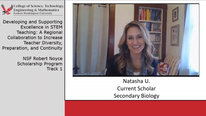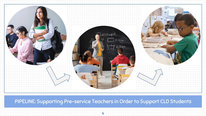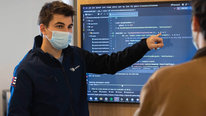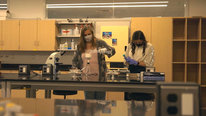- John Pecore
- https://uwf.edu/ceps/departments/teacher-education-and-educational-leadership/our-faculty/faculty-profiles/dr-john-pecore.html
- Professor
- Online Deliberate Practice of Questioning and Discussion Techniques
- University of West Florida
- Melissa Demetrikopoulos
- https://www.ncbi.nlm.nih.gov/sites/myncbi/1Piu8IFNGNSk5/bibliography/40979939/public/?sort=date&direction=descending
- Chair; External Evaluator for Noyce and ITEST projects
- Online Deliberate Practice of Questioning and Discussion Techniques
- Institution for Biomedical Philosphy
- Minkyoung Kim
- Assistant Professor
- Online Deliberate Practice of Questioning and Discussion Techniques
- University of West Florida
Public Discussion
Continue the discussion of this presentation on the Multiplex. Go to Multiplex









Mesut Duran
Professor of Technology
Very creative! I was wondering how the scenarios for avatar students were selected/developed? Thanks, Mesut
Minkyoung Kim
John Pecore
Professor
Thank you for your comment.
Our research project required STEM content that focused on questioning and discussion. We reviewed available scenarios from Mursion to avoid the expense and time of creating one. We determined that the math scenario of long division would work. An appropriate science scenario did not exist. However, another institution created a science scenario about the water cycle and gave us permission to use the scenario.
Minkyoung Kim
Mesut Duran
Professor of Technology
Very helpful! Thanks, Mesut
John Pecore
Professor
Thank you for watching our video. A few questions we have for you are:
Minkyoung Kim
Neela White
Project Director
Great video. I enjoyed learning about your project. Do the avatars offer opportunities for the pre-service teachers to simulate teaching for students with learning disabilities?
Toby Baker
Minkyoung Kim
John Pecore
Professor
The avatar software is developed by the company Mursion. The Mursion team spends a lot of time developing avatars with unique personalities. They have existing avatars that can be used for a project and you can pay to have an avatar developed. In one of our other projects focused on teaching culturally and linguistically responsive teaching, the class includes an English Learner avatar from Cambodia.
Mursion does have several avatars with learning disabilities including one autism and auditory/verbal communications.
Minkyoung Kim
Melissa Demetrikopoulos
Chair; External Evaluator for Noyce and ITEST projects
As John mentioned, Mursion allows for the development of new avatars. So, while we are not aware of any current avatars with learning disabilities, it may be possible to work with them to develop one. The students report that the avatars seem very much like real students even though they are generated by adult actors. Each avatar has a back story so that they have unique personalities. It might be challenging to avoid stereotyping when developing an avatar with learning disabilities, but it was something that did come up in the focus group with the students as something that would be helpful. In fact, in the one focus group, the participants reported that they felt that this experience should be a component of each of their classes because it was both engaging and gave them practice teaching.
Minkyoung Kim
Cathy Lussier
This was such an interesting approach. Many of our student teachers are used to full role-playing in video games so I imagine this would engage their interest and low stakes environment to try new things and make mistakes. I'm reminded of a paper I've read in the past (I'll put the citation below) where they found that STEM students who were working on problems during a simulated video game who were scaffolded by handouts performed better if the handout asked the question while they were in the simulation.
Pilegard, C., & Mayer, R. E. (2016). Improving academic learning from computer-based narrative games. Contemporary Educational Psychology, 44, 12-20.
Melissa Demetrikopoulos
Chair; External Evaluator for Noyce and ITEST projects
Thanks for sharing the resource Cathy.
You are correct that it allows them to "try new things and make mistakes." One of the things that some of the pre-service teacher reported was that it did allow them to not worry about impacting a real student while they were developing their skills, and to concentrate on the improvement of those skills.
Alexander Rudolph
Professor of Physics and Astronomy
This is a very creative approach, particularly the use of avatar students. I would like to know more about how the avatar students are programmed to respond to the teacher's questions appropriately. I also wonder if the teacher-students might get more out of the post-reflection exercise if they had a guided debriefing with an instructor. There is a great deal of literature about debriefing virtual, simulated experiences effectively, which shows that the participant's learning can be enhanced from that achieved through self-reflection alone.
John Pecore
Professor
The avatars are controlled by a real person (interactor) in real time os their is no "programming.' Each avatar has an individual profile that helps the interactor determine how to respond.
We did pilot a guided reflection/debriefing where we paused the simulation and then resumed the simulation. We did not see gains to justify the added cost of simulation time. Our model of deliberate practice where participants get timely feedback and reflection after the synchronous experience and more practice and feedback during the asynchronous learning (i.e. theorizing) component works well. Additionally, participants are provided three simulation experiences teaching the same lesson with the modifications based on feedback and reflection.
Melissa Demetrikopoulos
Chair; External Evaluator for Noyce and ITEST projects
Thanks Alexander. The program includes feedback from a trained facilitator and did not rely on self-reflection alone. This debriefing included general review as well as explicit comments based on particular sections of their teaching simulation. So, as John mentions, their modifications are based on both reflection and on the professional feedback that they obtain.
Toby Baker
My dissertation is in teacher training and higher education faculty training, so this is fascinating! This is an excellent tool for Pre-service teachers. Do you think colleges and school districts will adopt this form of Preservice learning?
Thanks. Toby at IC4.
John Pecore
Professor
We are working on a website and making the asynchronous component available through Canvas Commons. We are also working with our local school district on securing grant funding to offer the program as an inservice opportunity.
Melissa Demetrikopoulos
Chair; External Evaluator for Noyce and ITEST projects
As I mentioned in a prior post, the pre-service teachers indicated that they would like to have this be a component of all of their classes as it was engaging and it gave them simulated practice working directly with students. They reported that they need as much time teaching to students as possible and that this was like teaching to students. The biggest challenge is the cost of the avatar time which is why John mentioned that he is working towards additional approaches to this that are more economically scalable.
Jamie Mikeska
It is exciting to see the outcomes that you are achieving with this important research. Can you say more about some of the different approaches your team is working on that are more economically scalable?
John Pecore
Professor
We will be making the asynchronous modules available through Canvas Commons. The synchronous avatar simulations could be replaced with a classroom experience or simulation.